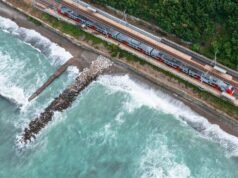Recent attacks against merchant shipping in the Gulf of Aden and Bab Al Mandeb have highlighted the risks associated with transiting these waters. The multiple types of risks and the broad expanse of ocean on which these attacks can occur dictate that Naval Forces must be used in the most efficient manner possible. To assist in this, CMF is establishing a Maritime Security Transit Corridor (MSTC).
The following information from the Combined Maritime Forces (CMF) relates to transits through the Gulf of Aden, Bab Al Mandeb (BaM), Southern Red Sea, and associated waters. It does not replace any previous guidance.
The MSTC will consist of:
- The Internationally Recommended Transit Corridor (IRTC)
- The BAM Traffic Separation Scheme (TSS) and the TSS West of the Hanish Islands
- A two-way route directly connecting the IRTC and the BAM TSS
 Overview of Maritime Security Transit Corridor (including Internationally Recommended Transit Corridor (IRTC))
Overview of Maritime Security Transit Corridor (including Internationally Recommended Transit Corridor (IRTC))
 Two-way route directly connecting the IRTC and the BAM TSS
Two-way route directly connecting the IRTC and the BAM TSS
 Enlarged image of two-way route directly connecting the IRTC and the BAM TSS
Enlarged image of two-way route directly connecting the IRTC and the BAM TSS
EU has adopted a new Regulation which establishes a new, comprehensive, legal framework for e-signatures, as well as e-identification, e-seals, e-timestamp, e-documents, e-delivery services, and website authentication which applies from the 1st of July 2016, replacing the Directive on Electronic Signatures (1999/93/EC). The importance of this Regulation is that unlike the previous Directive on Electronic Signatures (1999/93/EC), it is directly applicable in all 28 EU Member States without any need of being transposed into national law. Hence its implementation plays a direct effect in the Maritime field.
Legal effects of electronic signatures
As per Article 25 of the New Regulation an electronic signature shall not be denied legal effect and admissibility as evidence in legal proceedings solely on the grounds that it is in an electronic form or that it does not meet the requirements for qualified electronic signatures. Furthermore, a qualified electronic signature shall have the equivalent legal effect of a handwritten signature and shall be based on a qualified certificate issued in one Member State, and shall be recognized as a qualified electronic signature in all other Member States.
Furthermore, the Regulation defines three levels of e-Signatures: e-Signature, advanced e-Signature, and qualified e-Signature which have the following meaning:
(i) E-Signature is defined as data in electronic form which are attached to, or logically associated with, other electronic data, which are used by the signatory to sign.
(ii) Advanced electronic signature is defined as uniquely linked to the signatory, capable of identifying the signatory, and created using e-signature creation data that the signatory can, with a high level of confidence, use under his sole control.
(iii) Qualified electronic signatures defined as an advanced electronic signature created by a qualified electronic signature creation device. This type of e-signature is based on a qualified certificate for electronic signatures, which is issued by a qualified trust service provider.
Another important aspect of the said Regulation is that it includes a definition of trust services covering a wide range of electronic services, including electronic signatures, electronic time stamps and website authentication. The providers of trust services will be liable if they fail to comply with the security measures introduced by the regulations and as such each EU member states is required to establish a supervisory authority to supervise and oversee the work of qualified trust service providers.
Amongst the above changes there are also additional important changes made, and in conclusion this new Regulation has major benefits mainly that it creates greater confidence in cross-border online transactions and mainly the fact that electronic documents and signatures that adhere to the Regulation will not be denied legal status solely on the grounds that they are in electronic form. The new Regulation will ensure uniformity across the EU and will address the existing problem of different national rules on electronic signatures, which is due to every member state implementing the law individually.
The BAM TSS and the TSS West of the Hanish Islands
 Enlarged image of the BAM TSS and the TSS West of the Hanish Islands
Enlarged image of the BAM TSS and the TSS West of the Hanish Islands
When combined, these sections as a whole will be termed the MSTC. The purpose of this corridor is to provide a recommended merchant traffic route around which Naval Forces can focus their presence and surveillance efforts. It is recommended that all vessels use the MSTC to benefit from military presence and surveillance.
The formation of the MSTC has no effect on the use or timings of Group Sails or escorted transits of the IRTC. These will continue to be scheduled and executed as they have in the past. The IRTC end points will remain existent.
Operating in these waters requires thorough planning and the use of all available information. The maritime threat environment is dynamic; the risks will not remain constant for subsequent visits. It is essential therefore, that Masters, Ship Security Officers and Company Security Officers carry out detailed Risk Assessments for each voyage to the region and for each activity within the region.
All vessels transiting the Gulf of Aden and Bab Al Mandeb should follow the guidance of BMP4 to the maximum extent possible and consider the use of embarked armed security. Recent piracy attacks in 2017 serve to emphasise the importance of robustly following this guidance.
This guidance is in no way directive. The use of the IRTC, MSTC, BMP4, armed security, shifting transit times, or any other defensive measures remain the sole decision of the vessel operator based on its own dedicated risk assessment and the requirements of the flag state.
© Content from this site must be hyperlinked when used






